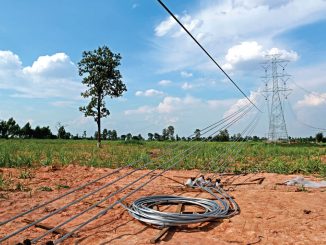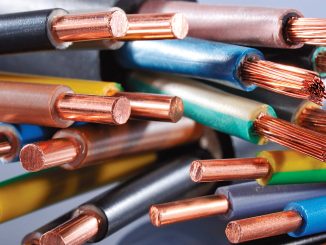
The transmission sector in the country has grown significantly in the past few years. As of October 2021, the total transmission line length in the country stood at 450,552 ckt. km (220 kV and above). From 2016-17 to 2019-20, the transmission network has grown at a compound annual growth rate (CAGR) of nearly 5 per cent, doubling every 14 years. With the anticipated increase in renewable capacity, the increase in generation needs to be complemented by a similar increase in the capacity and length of the transmission network. It is expected that the demand for conductors and cables will correspondingly grow at a rapid pace, in lockstep with the growth in the generation and transmission segments. Moreover, the growth in the transmission network will be accompanied by an upgrade and renovation of ageing transmission assets in order to increase the current-carrying capacity of these ageing assets. However, transmission projects are often delayed and stalled because of land acquisition issues and environmental concerns making it vital for transmission and distribution (T&D) companies to deploy advanced conductor technologies with higher ampacity and lesser right-of-way (RoW) requirements.
New-age conductors such as high temperature low sag (HTLS) conductors, high temperature superconductors (HTSs), aluminium conductor steel supported (ACSS), aluminium conductor composite core (ACCC) and aluminium conductor composite reinforced (ACCR) and gas-insulated lines (GILs) are capable of carrying higher currents and sustaining higher temperatures with limited heat and technical losses. While HTS and GILs are yet to see commercial deployment in the country, utilities have taken steps to install HTLS conductors and other high performance conductors. In India, aluminium conductor steel reinforced (ACSR) and all-aluminium alloy conductors (AAAC) are commonly used for transmission of power on overhead lines for the T&D system. As per the Central Electricity Authority (CEA), conductors constitute about 30-40 per cent of the total cost of the overhead extra high voltage (EHV) transmission lines and the type of conductor plays an important role in the quantum of power flow, T&D losses, height and design of towers, and span length of the transmission lines. It is, therefore, prudent for utilities to assess their requirement and choose the right conductor technologies.
Power Line presents a review of various advanced conductor technologies…
HTLS conductors
HTLS conductors are characterised by high temperature resistance and greater ampacity than conventional conductors. While the conventional ACSR and AAAC conductors are designed to operate continuously at temperatures of 85 °C and 95 °C respectively, HTLS conductors can withstand temperatures of at least 150 °C and up to 250 °C. Further, HTLS conductors have 30 per cent more capacity than that of conventional conductors and the low sag feature results in smaller tower requirement. Zirconium doped aluminium alloys maintain their electrical and mechanical properties at elevated temperatures as well, thus making these conductors cost and energy effective with enhanced capacity.
The existing transmission assets can also be reconducted with HTLS conductors when the structures or foundations of the existing lines have deteriorated or in cases where the transmission line needs to be uprated. However, lines above 400 kV do not require to be uprated because the existing thermal rating is already much higher than the limits on power flow related to voltage drop and phase shift.
HTLS conductors offer several benefits to utilities as they can be deployed in new transmission lines in addition to potential deployment for reconductoring existing lines. HTLS conductors can be deployed at the 220 kV, 132 kV and 66 kV levels as well as in the distribution system where there is congestion, such as in urban areas, and space is not available for addition of new overhead lines. These conductors can also be useful, if chosen judiciously, to get more benefits in terms of technical losses. At 400 kV, HTLS conductors can replace quad-bundle ACSR and AAAC conductors conditional on the length of the line. These conductors were deployed in the Gurgaon-Palwal transmission project commissioned by Sterlite Power. Power Grid Corporation of India Limited has also deployed twin HTLS conductors instead of quad/triple bundle ACSR conductors in multicircuit stretches. The company has also used high capacity aluminium alloy conductor, that is, Al59 conductor (which has about 25-30 per cent higher than a conventional ACSR conductor) as well as ACSS-type HTLS conductors.
Although the cost and thermal losses of HTLS conductors are higher than those of conventional conductors, they can enhance security reserves and transmission capacity without impacting the negotiated RoW, ideally with minor modifications of towers (mostly clamps of the conductors and their mountings or the light tower’s reinforcement) and sometimes fewer towers. There are some problems posed by surge impedance loading and the requirement of long transmission lines while deploying HTLS conductors. Further, these conductors require non-conventional methods of stringing and their operations and maintenance entails employing a skilled workforce.
Gas-insulated lines
Gas insulated lines (GILs) use gas with high dielectric strength as the insulating medium instead of air to reduce electrical clearance. They consist of aluminium conductors surrounded by a mix of nitrogen and sulphur hexafluoride inside an enclosure. GILs come with several benefits such as higher transmission capacity and lower transmission losses as compared to overhead lines and other types of underground cables due to the large size of conductors and lower resistance. These lines offer greater reliability with no risk of fire and have electromagnetic fields that are 15-20 times smaller than those of conventional power transmission systems. They offer high operational safety and longer life. GILs are ideally suited for cities that have RoW limitations for overhead lines.
GILs are mainly used in areas situated in close proximity to substations and in densely populated areas. Additionally, they are used to connect power plants to the transmission network. Moreover, GILs are extremely safe and reliable as they are fire resistant and do not emit noxious fumes under fire conditions. Resistive losses are low because of the large cross-section of the conductor and enclosure pipes. Typical GIL resistances are 6-8 metres per km depending on the outer diameter (500 mm or 600 mm) and the wall thickness of the enclosure and conductor pipe (6 mm to 15 mm). Underground GILs can also be installed in agricultural areas and the ground above is still viable for growing crops.
A GIL is designed for maximum operational temperatures given by the surrounding conditions – maximum 60 or 70 °C temperatures when deployed within a tunnel, or 40 or 50 °C when directly buried. The different temperature values depend on individual countries and their applied standards and regulations. They can, however, support maximum temperatures of up to 100-120 °C without demonstrating any symptoms of thermal ageing.
Issues related to GILs include deterioration in the insulation properties, owing to particle contamination and limited protection from seismic activities/earthquakes (in the case of underground lines) and limited maturity of the technology. Although GILs have been deployed by several global transmission and distribution utilities, there are not many examples of GILs in India.
High temperature superconductors
HTSs consist of several strands of superconducting wire wrapped around a copper core and a cryogenic cooling system to maintain proper operating conditions. These conductors have the capability to carry five to 10 times the current carried by conventional conductors – they can transfer more power using the same towers and line corridor. Further, HTS-based devices including cables, fault current limiters, transformers and energy storage solutions can limit over currents and protect the grid from damage.
They are compact in size and have a lower RoW requirement. Therefore, HTS can be installed in dense urban areas with a high load requirement with the existing RoW. They can also be used to connect two existing substations to create redundancy when transformer addition is not feasible. In addition, transmission losses associated with HTS are one-fourth as compared to conventional copper/aluminium conductors.
Also, electromagnetic radiation is suppressed by the HTS shield. These conductors can operate at a wide voltage range, from 5 kV to 765 kV, and have lower impedance than the conventional ones. In the current era, these superconductors are eminently suitable for deployment in areas with cold climate, given the inherent tendency of these superconductors to operate in low temperatures. However, their deployment is hampered by higher costs, distance limitations and overall system complexity.
Conclusion
The advances in conductor technologies alongside emerging smart grid technologies will help to spur the growth of the transmission segment. The deployment of HTLS and other high performance conductors will also enable transmission companies to curtail their technical losses and revitalise and upgrade their ageing assets.



